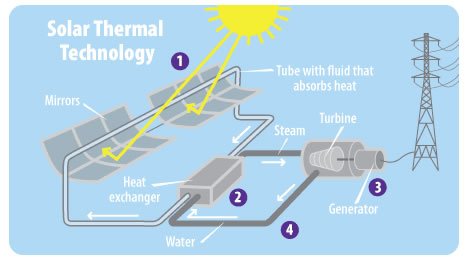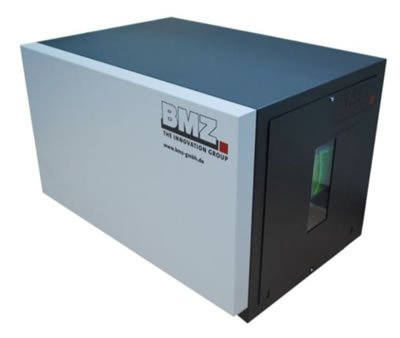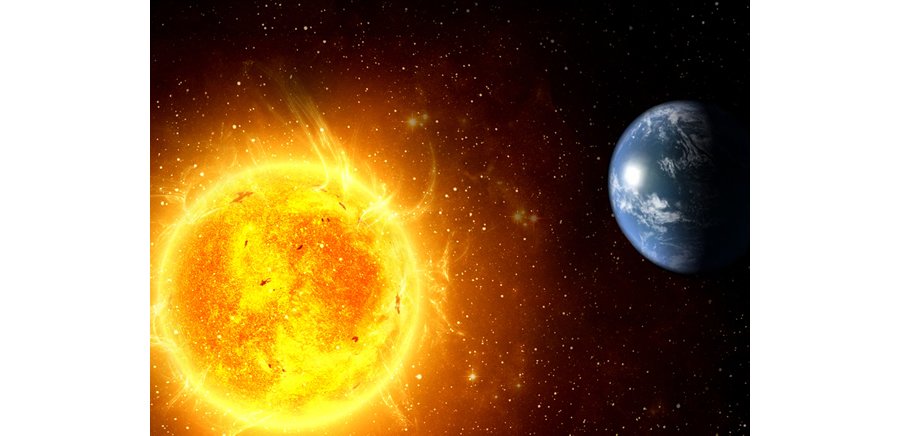Unbelievably, back in 1767, the first use of sunlight for heat generation was successfully achieved when a Swiss geologist and physicist, Horace Benedict de Saussure, created the first solar oven. He put together a simple pine box with three glass layers. Two smaller boxes were placed inside with black inner coating. When the sun’s rays infiltrated the glass cover, the blackened insides absorbed them, converting them into heat. The glass trapped the heat inside. He was able to produce temperatures of 230 degrees Fahrenheit in his little oven that did not vary regardless of the outside temperature. This established that external air temperature played no significant role in this solar heating process.
Creative minds have continued to figure out how to harness the sun’s energy for a variety of purposes. Today solar energy is gaining in popularity as a way to provide electricity.
 Heat Energy Converted to Electricity
Heat Energy Converted to Electricity
Heat energy (also called thermal energy) is produced and used to heat water for use in homes, swimming pools, to heat buildings, greenhouses, etc. On a larger scale, this heat energy can be used to heat fluids to high temperatures to operate turbines1 that generate electricity that can be sent directly to the energy grid. This is one way solar energy is converted to electricity. These systems are called Solar Thermal Systems. The oldest thermal solar power plant in the world is in San Bernardino County in California.
Another Way to Convert Solar Energy into Electricity
Another way to convert solar power to electricity is through the use of devices with a fancy name called Photovoltaic devices (PV devices). Or they can simply be called solar cells. These are nonmechanical devices that convert sunlight directly into electricity. The solar cells are grouped into panels and arrays of panels that can be used in a variety of applications from small systems that provide energy for watches and calculators to systems that power homes with a unit directly on the roof, to large power plants covering many acres, providing electricity directly to the energy grid.
As a matter of fact, if 4% of the world’s desert areas were covered with PV systems, all of the world’s demand for electricity could be supplied. So there is a future here.
The world’s largest PV power station called Solar Star is near Rosamond, California using 1.7 million solar panels spread over 3,200 acres.

Benefits
- PV systems can supply electricity in locations where modern electricity distribution systems do not exist.
- They can also provide electricity to existing power grids.
- They can be installed quickly and can be any size.
- There is minimal environmental impact of PV systems—no air or water pollution, no greenhouse gases.
Drawbacks
The Thermal Solar Plants require water for cooling turbines and cleaning the collectors. There are towers that birds can fly into and to this degree they have an impact on the environment.
The PV plants have much less impact. It’s not uncommon to see PV plants with cattle grazing around them.
 Energy Storage
Energy Storage
Setting up solar energy production and then utilizing a state of the art lithium Energy Storage System you can literally become independent of the power grid—business or residential. The BMZ Energy Storage unit is ideal for home or small commercial use. This “battery” is 26.75” wide x 18” Deep x 21.6” High. We are currently working on a commercial project where 14 of these units will be used to provide the storage they need in conjunction with their solar production system to become grid independent!
What does CES have to do with Solar Power and Energy Storage?
At CES we are all about energy solutions! We can help you understand and get a complete solar power system. Just like with all of our traditional energy suppliers, we have solar system suppliers who can help you if you are a small operation or a sprawling, gigantic facility. We will always work to get you the best system for your needs. Call Jeannine at CES today at 844-277-0043 for more information.



